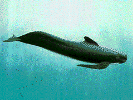
Via television and news photographs, millions of people have seen herds of long-finned pilot whales lying in pools of blood along the coast of the Faroe Islands, north of Scotland. Every year, the Islanders drive the whales to shore and slaughter entire herds. It is easy to do once the whales are located. Pilot whales are so social that if one strands, even accidentally, the others usually come ashore too. If individuals are pushed or towed out to sea, they often return - only to die.
Pilot whale, or "pothead," hunts have taken place in several areas of the world during the past century, including off the coast of Newfoundland. The Faroe Islanders have been hunting pilot whales for at least four centuries and perhaps thousands of years. But today's Islanders no longer depend on whales for food. Population studies have been conducted but are not complete. Still, the traditional hunt, which harvests about 2,000 animals a year, carries on.
Globicephala melas
Size: Males 5.5 to 6.2 m (max 8.5 m), 3,000 to 3,500 kg. Females
3.8 to 5.4 m (max 6 m), 1,800 to 2,500 kg
Calves at birth: 177 cm
Teeth: 8 to 12 peglike teeth on each side of upper and lower jaws
Food: Squid, octopuses and fish (cod, mackerel, hake and others)
Habitat: Mainly deep offshore waters
Range: Temperate and subpolar Atlantic, Indian and South Pacific
Status: Population unknown. Has been caught by shore-based whalers,
especially in the North Atlantic
